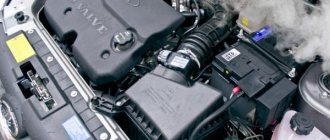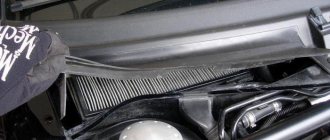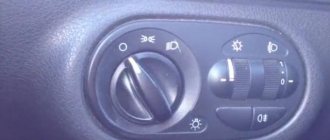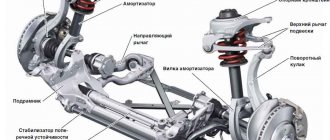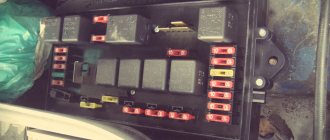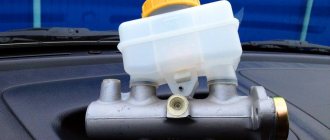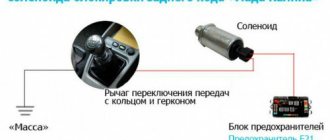There are many different reasons why the windshield of a Priora sweats, but the main reason that underlies all the problems of sweating windows is condensation in the car interior. In other words, condensation in the cabin can be described as moisture inside the cabin, namely on the rugs or under the carpet.
Another reason, quite normal, may be fogging of the glass due to temperature differences. This most often happens in cold weather, when the temperature inside the car and outside differ greatly. Or when there are several people inside the car, the humidity in it rises, which aggravates fogging and freezing of the windows in cold weather.
As you can see in all cases, the cause of fogging of the windows is moisture in the car interior, and in order to overcome fogging of the windows in the Priora, you must first get rid of the high humidity in the cabin.
How to properly dry a foggy headlight
- It is necessary to remove the lamps from their sockets to provide additional air flow. If water accumulates in the lower part of the body, you can remove it with a syringe and a thin tube inserted through the hole. To speed up the drying process, it is advisable to expose the car to the sun. You can heat the headlight with a household hairdryer, directing a stream of warm air into the hole for the lamps. However, do not place the hair dryer too close. The use of a hair dryer is unacceptable! High temperatures can melt the glass and housing, and also cause the reflector coating to peel off.
- Another option for faster drying (for example, on the road): remove all plugs and ventilation hoses for additional air flow. Remove the dimensions and turn signal lamps from the connectors. Then turn on the headlights to heat the housing.
Why should it be eliminated?
It's simple, and there are several reasons for this:
- The efficiency of lighting drops significantly; if you like, it can be compared to a dirty headlight. Which is already dangerous, because you simply may not see the crossing pedestrian.
- Fogging is often accompanied by the accumulation of water inside the headlight, which leads to corrosion and destruction of all metal parts of the headlight. Although now many manufacturers are made of plastic, the lamp itself is made of glass and metal.
- If moisture gets on a heated lamp, it may simply burst.
- Water is a good conductor; it can short-circuit the lamp contacts. At a minimum, it will burn out, at a maximum, the fuses will blow out, and if this happens on the road, you risk being left without road lighting.
- The lamps will burn out more often, again due to moisture getting on the contacts.
In general, problems are guaranteed, so something needs to be done. Often the reasons are trivial.
Depressurization of joints and seams
Another answer to the question of why the headlights sweat and what to do may be the depressurization of the butt seams in the places where the lampshades are attached to the car body. The fact is that it is impossible to completely hermetically attach the lighting unit to the body of the body.
However, this defect is also typical for Russian cars of later modifications. For example, any car service worker responds to a complaint like “the headlight on Kalina is sweating, what should I do?” will probably recommend using a can of silicone-based sealant. This product is easy to apply, dries quickly, and also provides fairly high levels of tightness and moisture permeability.
How to eliminate fogging at home
You can begin to solve the problem yourself after the exact cause has been established. It is impossible to detect microcracks in plastic with the naked eye. In this case, the headlight will sweat over its entire surface, and not in any specific place.
To check the device you need to:
- Remove the terminals from the battery;
- Unscrew the light bulbs;
- Clean the body;
- Check for cracks in the seams.
If the headlight fogs up due to cracks in the seams, it is necessary to clean the surface of the old glue. Next, dry the headlight and degrease the surface. We seal the headlights with sealants. A silicone-based mixture is best.
To check the plastic for microcracks, it is immersed in water. The presence of cracks reveals air bubbles. A colorless sealant will help correct the situation. Another way to repair a crack is to seal it with instant glue.
Checking the tightness of seams
The first step is to carefully inspect all seams and fastening points for their tightness. If you find areas lacking it, cracks or chips, you need to use a special moisture-resistant sealant.
The situation is much more complicated when the joints and seams have microcracks that are invisible to the naked eye. It is almost impossible to detect them without special optical, electronic or laser equipment. If microdefects form, the answer to the question of what to do if a car headlight sweats is practically the same. Go to a car service or service station.
Proper cleaning and assembly
The dried headlight must be cleaned thoroughly. It is strictly forbidden to use hot water, scratching sponges or aggressive agents. The best option is dissolved laundry soap and a soft cloth. Don't rub too hard, just swipe very lightly over the surface. Thoroughly pour the cleaned elements with distilled water and leave to dry.
It is advisable to use soft gloves when assembling the headlight so as not to leave marks. Apply sealant to the seams to avoid tears. After connecting the body to the glass, leave it to dry for 24 hours. Then you can check the structure for leaks.
What to do if the headlight on a Lada Granta sweats? If you are not confident in your strengths, knowledge and capabilities, contact a specialist. The most dangerous moments in disassembling the headlight structure are removing the sealant, as well as heating the product. But if you have the skills to do this kind of work and do everything carefully, then you can solve the problem of headlights fogging on your own. Be sure to use only a special sealant that is designed for headlights.
Universal recipe
First of all, it is necessary to mention the universal method, which is often offered as an answer to the questions “the headlights are sweating, what to do.” We are talking about the so-called “dry heating” of car headlights. This method allows you to get rid of such a defect if it occurs once or from time to time. The algorithm of actions when using this method is as follows:
- First you need to dismantle the lampshade of the light block;
- after which you need to loosen the light bulbs and slightly remove them from their sockets;
- turn on the low beam and let the lamps work a little, “warm up”;
- turn off the optics and return the headlight cover to its place.
What is the danger of fogging up the optics on a car?
If the front headlight and rear signals are sweating on Grant, then problems may soon appear:
- The quality of lighting decreases. The appearance of condensation can significantly distort the light flow and lighting efficiency.
- Contacts oxidize and corrosion appears on metal parts. The metal begins to rust, other parts with a reflective coating oxidize, it loses its properties, the functioning of electronics is disrupted, and blocks often flood.
It is very important to fix these problems quickly so that the devices work properly. Otherwise, headlight repair or replacement of individual elements may be required.
Causes
Experts identify several reasons for the occurrence of condensation:
- Violation of the optics design. This can happen as a result of an accident. The integrity of the headlight does not guarantee its tightness. As a result, the car's headlights sweat from the inside. What to do in this case? There are several options - repair or replacement. But since modern optics are very expensive, you can try to restore the old one. But this is not a 100% guarantee - you may have to replace the entire unit. We also note that foggy headlights are a bad sign when buying a car second-hand. Perhaps it was a “drowned person”, or the car was involved in serious accidents, where a violation of the body geometry is possible.
- Tuning is not based on technology. Recently, more and more motorists are installing xenon and “angel eyes”. But the very next day the result is disappointing - the headlight begins to sweat and distort the light. This is a consequence of incorrect disassembly of the optics. When installing glass, it is important to completely clean the joints of old sealant. Even the slightest crack will cause condensation to accumulate inside. Some people damage the unit mechanically during disassembly. To eliminate this, the headlight is placed in the oven. This is necessary in order to soften the sealant. At room temperature, the factory seam is very tight and it is almost impossible to remove it.
- Poor fit of bulbs. In the case of an abnormal xenon installation, this may be a leaky hole for the ignition unit. This banal phenomenon can cause moisture to accumulate on the walls of the headlights.
- Ventilation ducts. Over time, they simply become clogged. As a result, moisture cannot leave the block and condenses on the walls of the glass. Priora especially suffers from this.
We will tell you exactly what to do if the headlights on a Priora sweat at the end of the article, but for now we will give recommendations on how to get rid of this problem in general.
Why do my headlights fog up?
The causes of fogging may be the following:
- violation of the integrity of the headlight housing;
- destruction of the sealant layer connecting the glazing to the body;
- violation of the tightness in the places where the wiring is supplied to the light bulbs;
- microcracks in headlight glazing;
- clogging of ventilation ducts and holes that provide air circulation in the headlight;
One way or another, all of the above malfunctions lead to a violation of the headlight seal. Depending on the specific source of condensation inside the optics, there are various ways to eliminate fogging from the headlight.
What to do when the headlight on a Lada Granta sweats? how to dry?
Most likely, you will have to disassemble, dry and clean. You will need to pull the lamps out of their sockets to increase air flow. You can perform the following operations:
- If water is collected in large quantities, then it can be collected using a syringe and tube. It is better to leave the car in the sun.
- Sometimes such trouble can occur on the road. Then the plugs are removed. After this, all the lamps are removed except the headlight. Turn on the headlights to warm up the entire body.
- You can also use a regular hairdryer. Direct the flow into the holes for installing lamps, but do not bring it too close. It is strictly forbidden to use a hair dryer. It heats the air to high temperatures, the body and glass can melt, and the reflector coating can peel off.
If, over time, moisture appears in the headlight again, then you need to look for the reason for its accumulation.
Fogging headlights - how to deal with this phenomenon
Fogging of headlights from the inside is not as harmless a phenomenon as it seems at first glance, when steam and moisture accumulate on the glass of the optics, the illumination of the road at night becomes worse, and accordingly, the level of safety of the driver and passengers in the car decreases. Car owners often ask the question: if the headlight sweats, what should you do in this case? In this article we will look at the reasons for fogging of car optics and possible methods for eliminating this problem.
Why do car headlights sweat from the inside?
The headlight often fogs up in humid weather or after a car wash. Moreover, this phenomenon does not depend on the mileage of the car; the headlights inside can be damp even on a practically new car. A car headlight (tail light) is a closed space in which, as the temperature from the incandescent lamp increases, the internal pressure also increases. To prevent excess pressure from being created, all automotive optics have special valves.
The purpose of the valves is to let air in and out of the optics, but dust, dirt and water should not fly into it. In the evening after a trip in the off-season, the headlight cools down, the pressure in it decreases, and moist air enters through the valve. Moisture condenses on the glass, causing the optics to fog up.
There is nothing wrong with this if the moisture quickly evaporates after the car warms up and starts moving. But condensation does not always go away, and then it already causes a lot of problems for the car owner. The most common cause of the defect is caps falling off the ventilation valves; in this case, the optics require repair.
Also, moisture can penetrate into the headlight through a barely noticeable crack in the glass or in the housing - if condensation lingers in the optics for a long time, it must be repaired.
Ways to eliminate fogging of headlights
There are several ways to eliminate fogging of headlights in a car, it all depends on what defect is detected in the optics. If a crack is found on the case, it must be soldered using a soldering iron or hair dryer; you should be aware that in this case it will not work:
- seal the crack with glue;
- seal the defect with tape or adhesive tape.
The headlight is made from special ABS plastic, which cannot be glued together.
Glass is often glued to the headlight with silicone sealant; over time, the sealed layer sags, and moisture gets into the optics through small gaps. To eliminate the defect, in this case, you should remove the glass and lay a new layer of sealant.
If the cause of fogging of the flashlight is the ventilation valve, it is necessary to eliminate the defect - clean the valves from water and dirt, provide air ventilation. Unfortunately, valves for headlights are not sold separately, so you have to rebuild them.
There are several popular ways to combat fogging of car optics; car owners fix the problem like this:
- place a bag of silica gel in the headlight housing (the substance absorbs moisture well);
- pour some brake fluid into the optics.
Each of the methods has its own side effects: the brake fluid causes the glass to become cloudy, and the silica gel itself swells with water over time and can damage one of the elements inside the structure.
In some cases, foggy headlights are a design flaw, but car manufacturers are aware of this and are taking all measures to combat the unpleasant phenomenon. For example, the Kia company standardly installs containers with silica gel on some models; a similar Kia Sorento headlight can be seen in the photo below.
Fogging headlights on Priora
On Lada Priora cars, the optics sweat very often; the problem occurs on almost every second car. The reason for the defect is that the back cover does not fit too tightly to the body, because of this moisture penetrates into the optics. To fix the problem, you can try replacing the rubber seal. But still, the main cause of the defect is poor ventilation; you must first of all pay attention to the ventilation valves.
Here is one way to deal with headlight fogging on a Priora; it is better to do this in warm (hot) sunny weather:
- We install the car with optics on the sunny side;
- remove the rear covers from the headlights;
- warm up the insides of the optics with an ordinary hairdryer;
- We heat the silica gel in a frying pan, pack it in cloth, and place it in the case so that it can then be easily taken out.
You need to keep an eye on the silica gel and change the bag when it swells.
Elimination of defects in Lada Granta taillights
On the Lada Granta, as well as on the Kalina, the taillights often sweat in the winter, and in the summer they get clogged with insects and dust. How can you deal with such an unpleasant phenomenon?
Let's consider eliminating a defect on Grant's car:
- disconnect the protective cover in the trunk, turn off the power from the optics, remove the rear light (it is secured with three 8-mm nuts);
- thoroughly rinse the glass, place the lantern in a bath of water, add two or three drops of Fairy to wash dishes;
- after washing, let the plastic dry thoroughly;
- install the flashlight in place, take a bag of silica gel, attach it to the back of the optics, for example, between the wires;
- seal the lantern - seal it with tape at the back;
- We put the plastic in place and close the lantern with a plastic plug. After the work has been done, the lights should not fog up for a long time.
Fogging headlights on Hyundai Solaris
Headlight fogging can occur on any car model, and the Hyundai Solaris is no exception. There is nothing wrong if the optics sweat in damp weather, and 5-10 minutes after turning on the light, the condensation from the glass disappears. If the Hyundai Solaris is under warranty, if the defect is severe, in many cases official dealers change the optics under warranty, but often car owners have to solve this problem themselves.
As mechanics explain, the headlight sweats because the headlight glass shifts on its plane due to vibrations of the car, and air and moisture enter the optics housing through the joints and irregularities of the sealant. To eliminate the defect, it is necessary to remove the headlight, dismantle the glass, and re-glue it with silicone sealant.
https://www.youtube.com/watch?v=uQhl0A9ibVI
If the headlight is foggy and you need to drive urgently, we use the following method:
- open the rear housing cover on the headlight;
- turn on the high beam;
- wait until the condensation from the glass disappears.
Lada Priora Sedan 2009, 97 l. With. - breakdown
Cars for sale
Lada Priora, 2013
Lada Priora, 2013
Lada Priora, 2008
Lada Priora, 2011
Comments 35
Dry, coat the lids with silicone and put them on correctly. Unless, of course, there are holes after inserting angel eyes) It helped me.
Also a trick! took it, opened it, changed the dimensions to LED ones, closed both, the right one didn’t fog up, the left one got stuck! then I came with a fan and dried the left headlight, took it with the right plug and swapped places, now both started to fog up... I don’t know what to do? tell
Poor seal pressure at the rear.
Same situation. I changed the low beams in the garage. Although, it’s a draft, it’s winter. And the left headlight also fogged up. There’s just condensation there. Most likely because of the humid air. Well, on the other hand, if I changed it outside and in the cold? Everything seems to be fine I installed a place, a plug (Bosch headlights), I really didn’t remove the battery. But everything is in the latches in place. And in the morning there is frost on the glass, I’m thinking of doing what comrade ruslan28a suggested above, or just remove the battery and dry it with a hairdryer, I went with my original lamps more than a year and a half and no problems.
check the drainage holes if they are sealed, it will sweat; it’s not a matter of tightness, but these holes can be solved simply at the very least, several times on different machines I drilled additional drainage holes and paired tubes in them so that dirt does not get into the joists
What can I say - the Russian auto industry) The same disease started for me, only after replacing the light bulbs. Many people sweat from the factory, mainly the left headlight. There is only one way out - to re-glue
This is also a problem, they don’t sweat from moisture, it’s just the sealant, I took apart some kind of coating inside the glass twice, and I also noticed that after assembling the headlights, it’s advisable not to turn on the low and high beams for a week, and use foglights, then it’s less likely that they will completely fog up drying out of the headlights (but not from moisture) But there was a problem with moisture in the drainage hole; a spider had stuck a web there and the headlight was suffocating...
where is the drainage hole?
there are two of them, 1 is a white insert under the headlight, and 2 are somewhere on the side
Both of mine were sweating, but the left one was sweating more, it happened after replacing the low beam bulbs. I solved the problem this way, and it will most likely help you: Opened both plugs (or whatever they are called, through which the lamps are changed) on both headlights, started the car, turned on the high and low beams together for 10 minutes, without turning off the headlights, put on the plugs and after that that’s it it was fine. Those. the headlight warmed up, the moisture evaporated...
